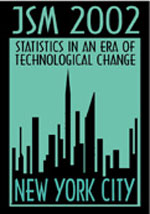
|
Abstract #301435 |
|
The views expressed here are those of the individual authors and not necessarily those of the ASA or its board, officers, or staff. Back to main JSM 2002 Program page |
|

|
Abstract #301435 |
|
The views expressed here are those of the individual authors and not necessarily those of the ASA or its board, officers, or staff. Back to main JSM 2002 Program page |
|
Back to the full JSM 2002 program |
||||||||||||||||||||||
|
JSM 2002
For information, contact meetings@amstat.org or phone (703) 684-1221. If you have questions about the Continuing Education program, please contact the Education Department. Revised March 2002 |